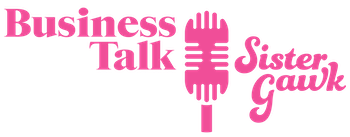This week, we dig into what a customer service coach does to help businesses by interviewing Dr. Kelly Henry. He tells us his professional journey in getting to where he is today with life lessons he has learned that ultimately lead him to start his own consulting business. He gives us some great insights on customer customer service to increase sales, so stick around fun conversation!
Welcome to Business Talk Sister Gawk! I’m Bekkah! And I’m Ruthie! And today we have a special guest that we are super excited about his name is Dr. Kelly Henry, the Customer Experience Doctor! Thank you so much for being with us!
Kelly: Well, I appreciate it! Thank you so much for allowing me the opportunity to be on your show!
Bekkah: Yeah! Well, the first question we have for you is what do you do?
Kelly: What do I do? Well, I am a retired chiropractor turned consultant and coach and I specifically coach and consult with businesses on how to improve their customer service to increase their profits and growth.
Why Did You Get Into Consulting Businesses About Customer Service?
Ruthie: That’s awesome! And what got you into that? What was your why behind going into consulting?
Kelly: That is a great question, well, I have been coached for many years. I was thinking back and I think 2003 was when I hired my first coach and I just knew the benefits of it. I’ve seen the tremendous benefits that I have incurred throughout the years from having different coaches. In fact, I still have coaches that work with me now and I know the powerful impact that they’ve had in my life and my business. I knew I wanted to do that.
The reason I coach and consult on customer service is because that was a foundational principle in my chiropractic offices. That was something we were known for and I implemented early on in my business. I studied, learned, implemented, trial and errored, and grew and just love it! I also know the impact it had on my business but other businesses and now with my clients. So I just meshed the two together – the consulting and coaching with the customer service and that’s where I am now!
What Made You Decide to Go to College?
Bekkah: What kind of background did you start out with? Did you go to college? Did you always want to be a chiropractor? Then walk us through the journey of how you decided you were going to move on to something else.
Kelly: Okay, yeah! Another great question. I became very interested in being a chiropractor when I was in high school. We had a family friend that was a chiropractor that obviously talked it up and piqued my interest. In going to college, I decided, yep, that’s what I was going to do. Went to college my freshman year and I didn’t fail out, but I really did terribly.
The Lesson I Learned From Doing Manual Labor
I decided to take a semester off probably give up on chiropractic, broke my mom’s heart. I started working for a landscaping company and this is in Colorado so this was going into the fall and winter of the year. For about five or six months I was shoveling snow, raking leaves, being out in the cold, doing manual labor and after six months of that I decided, “You know what? This college thing isn’t so bad! I think I’ll go back!” *Bekkah laughs*
Before my parents paid for all my college, at least that first year of college, and when I decided to go back my dad said, “I’m not doing that anymore! I’ll pay for your books. You pay for your tuition.” That changed the whole mindset. My whole mindset of “you know what? I better start being a little more serious with this.” So I did and got much better grades, turned things around, got back into the focus of being a chiropractor.
I ended up getting a degree in anatomy, went to chiropractic school here in Dallas where I live now. That’s why I’m here. I fell in love with the Dallas area back when I went to school in the mid to late 90s. Side note – I met my wife here. Her cousin and I sat right next to each other in chiropractic school. Funny thing how God works things out in our lives, but she was living here and working and we met and she had to have me and so we got married. Or I had to have her. One of the two, something like that, but we’ve been married almost 25 years!
Ruthie: Congratulations! That’s awesome!
How I Decided to Buy a Chiropractor Business
Kelly: Thank you! I’ll make it a long answer to a short question but I graduated chiropractic school and went to Phoenix for a year and just did terrible. Complete disaster. Fortunately, I met a chiropractor in New Mexico where my wife was from. He was retiring and I decided to buy him out or had the opportunity to buy him out. That’s what moved me to New Mexico and then a few years later there was another chiropractor in the community that was retiring and I ended up buying him out, too.
How I Decided I Wanted to Be a Customer Service Coach
I started getting coaching. I had the customer service down pat and so I really was able to grow my practices to something significant. Both of the chiropractors, I believe, were in their 60s at the time and basically had nothing left for me to buy, which was good for me because I didn’t have to pay a premium on it, but obviously, they didn’t get much out of it.
I made a mental note of that. I decided, “You know what? If I decide to retire and sell out, I’m gonna do it while I’m at the top and have something to sell that’s significant,” And that’s what I was fortunate to do in 2018. With that, going forward, kind of like I mentioned earlier on, I’ve been coached, I knew the impact of that. I wanted to coach and I knew and know the impact of customer service so again I just put those two together and ran with it.
Ruthie: Yeah! That’s awesome! You kind of mention a couple of things that I wanted to comment on. One was when you really had to take college seriously. We just did a couple episodes with our other sister, Rachel, about the Pros and Cons of College and that came up several times. College is an investment and it needs to be treated like one. *laughs* I just thought that was interesting to see.
Kelly: Yup. I didn’t realize that my first year. I thought it was my escape from home and I could do whatever I wanted and that’s not how it’s supposed to be.
What Lessons Did You Learn Buying a Business?
Ruthie: Along the lines of what you were talking about with buying out those different businesses you kind of had two different rounds or influxes of customers and that had had different experiences. Based on your personal experience with your practice buying those businesses how are you able to beta test a lot of techniques for customer service?
Kelly: I didn’t have a beta test a whole lot. The key to customer service, at least in my philosophy and how I coach and consult is just treating people right. Helping them to feel valued and important, so it didn’t matter that I took on this chiropractor’s patients or this chiropractor’s patients, they still wanted to feel valued and important from me and my office staff so that wasn’t a big deal.
Something that’s a little off, not necessarily aligned with customer service, that I learned and I wish I would have known going in, I tried to be everything to those other chiropractor’s patients like they were used to. I tried to mimic those doctors and that’s just impossible. That’s not what I did. That’s not who I am and it was very frustrating for them and certainly for me.
I finally realized, “You know what?” This is what I do. This is how I do it. I’m sorry I can’t do it like Dr. So-And-So, but you know, you’re with me now. We’re going to value you. We’re going to take care of you, but you’re just going to have to get used to the way I do things.” That was somewhat of a large learning curve for me to undergo as I took on those two practices.
How Does Customer Service Increase Sales?
Bekkah: When we had originally connected, Ruthie wasn’t able to be part of that conversation, but one of the things that you really touched on and that’s why I was like, “Oh, this is what we’re going to call this episode!” you said you came across some data that said, “Hey, if you can just do this, it’s going to totally increase sales by this amount.” I think you mentioned a Harvard Business study or something. Could you tell us about that and what really set you on that track originally?
Kelly: Absolutely. Well, before I get to the stat, this is what happened in my office. I was so focused on acquiring new patients – just always new patients. I need more new patients to grow my business and that’s good, we all need new business, we all need to acquire new customers. That’s part of business and part of growth but I didn’t see and I didn’t focus on what I needed to do to keep those patients in my business as much and make sure they continue to feel valued and were important to my business.
That is my whole philosophy now in my coaching and consulting with businesses – let’s focus on retention. That brings us to the stat you are referring to. It was a study done by Harvard Business School and what they found out is if you will just increase your customer retention, which is done by improving your customer service, but if you’ll increase customer retention by just 5%, keep 5% more customers buying from you in repeat sales, people who continue to do business with you – it can lead to 25% to 95% percent increase in profits.
Ruthie: Wow.
Kelly: Just a measly 5% can lead to just phenomenal profits! That’s my whole purpose in my coaching philosophy and the principle that I try to get across. Let’s just improve your customer service enough to bump your retention rate up by 5% and often it’s way more than that once we get the program in place and implemented, but just a measly 5% and then just watch what happens and how this will affect your bottom line and the growth of your business.
How Did You Decide to Sell Your First Business?
Bekkah: As we’ve seen you go through this journey before we move on to “how do you do your current business” we’re really wondering about when you did you say, “Okay, now I’m going to make this goal to do really well so that when I’m at my prime, that’s when I’m going to sell.” What was your actual goal in that? How did you know you were at your prime and how did you get ready to make that transition to sell your business?
Kelly: Well, my intention or goal wasn’t necessarily to get to that point to sell out and just have a phenomenal practice to do that. I’m very goal-oriented so I always have goals to drive me and a new level of how many patients and revenue and all the things I was doing. I was always just driving towards that no matter what. When I got to the point where I knew that it was time to sell out and it felt like I was led to do that, my body was starting to break down a little bit.
I had a high volume practice so I was treating between 350 to 400+ patients a week. And I loved doing it but I was feeling the effects on my body from that, on my neck and upper back and my shoulders. Again, I knew it was time and it was felt like I was led to go and sell things out. My goal, at that point, once I determined that it was time was more of a mentality. If I was a young chiropractor coming in that was going to buy my practice I would, personally, want something you know – yeah I had a lot of success – but I would want something that is just basically I just have to turn key, walk in, and take over for me.
So I started looking at my practice very objectively and said, “Okay, where where are some weaknesses? Where are some things that I need to improve upon? Where can I sure things up so this doctor coming in is just gonna have basically guaranteed success because I’ve just set him up for that by the way I ran my practice?”
Fortunately, that’s what happened. The doctor bought me out. Dr. Richard Abercrombie is phenomenal! He’s been great to work with. We get along tremendously. He’s just taken off and actually, he’s grown the practice above and beyond what I had so that was my mindset. I want something phenomenal for somebody to walk into so they can be successful and basically have the same success and feel the same success that I felt and had as I went through my journey.
How Do You Consult People on Customer Service
Bekkah: So now you’re doing consulting in customer service, how do you do that?
Kelly: That’s a great question, basically, I get with a client when they hire me on and we do an in-depth audit. I have a very specific program that I’ll take them through. It’s called the 5% bump program, based on the stat that I mentioned just a moment ago. We just go through and find the good and the bad of where they are and their customer service for their business.
There are usually a lot of places where there are holes. We’ll implement first the areas that are going to make the greatest impact the quickest. We can get some momentum going, some success going, some profits increase going, and that always excites the client. Then we’ll work through the rest of my program. Every business is different, obviously, so we take unique aspects for the business and what’s going on with them and we will monitor, we’ll adjust, and refine my program to fit with their particular business and how they run things.
Then we just continue to monitor and maintain once we’ve implemented. We guarantee that we have consistent growth, we have consistent success and maximize what they’re trying to achieve with the program.
How Have You Seen Customer Service Impact People’s Business Success?
Ruthie: What are some of your success stories in seeing how customer service has really impacted people’s businesses?
Kelly: The two I get all the time is – part of my program is changing the dynamic in the business and how the employees are treated or looked at. You have to treat your employees as well, if not better, than the customers, because if you’re not treating employees well it’s foolish to think that they can turn around and then treat the customers well. That’s an aspect of my program that we sure up and make sure is on point but I always hear that “okay, we’ve done that and the business atmosphere is so much better.”
The employees are so much happier. They enjoy coming into work. They don’t complain anymore. They want to stay in the business and continue to work there. You retain employees as well which saves on trying to hire in and that can be a huge headache and that cost of training and the things that go along with that. I hear that a lot, “Man, the business as a whole is doing great but just how the employees are working better it just makes it such a more enjoyable place to work. Everybody’s happy”
The second thing is obviously the profit. You know, bumping up the profits. Double, triple businesses, a hundred thousand dollars in less than a year – just explosion in profits. That’s always fun too. It’s good. I always love to hear that, but I always want to make sure that, when we’re going through this and this is part of the principles that I teach and coach on is you need to have the service mindset. I love a quote by Zig Zigler, “You can have everything in your life you want if you’ll help enough others get what they want.”
We always want to bring it back to where customer service is about serving. You’ve got to remember that. Serve first and then you can have the profits, you can have the growth, but let’s focus on the serving. A lot of businesses focus on sales, and they have a sales mindset all the time. What I try to get my clients to understand is “let’s have this service mindset and you’ll have more sales.”
The Key to Customer Service is Treating Employees as Assets
The key to creating a better office environment – and I was guilty of this! Just to give a little story here, there was a long – well not a long time, but there was a period in my chiropractic offices where I only thought of my employees as liabilities. They were only there to get a paycheck. They were only there to do the bare minimum and it was my job to make sure they were on task all day, every day and soon as they messed up I needed to make sure it was corrected.
Finally, one of my coaches called me out on it and said, “Hey, listen. You gotta quit doing that. You need to start looking at your employees as assets and start focusing on the good they’re doing because they are doing way more good than they are doing bad.” That was a game-changer for me! Once I had started recognizing that and having that attitude so that’s a key component is to look at the employees as assets and start recognizing all the good they’re doing, but not only recognizing it but make sure you are telling them they’re doing a great job. Tell them, “Hey, you did a great job here! I really appreciate you doing that! You’re doing so fantastic here.”
You want to continue to do well. They appreciate the compliments, they appreciate being recognized for doing good work, That just fosters that mentality of them being an asset and again showing value to them which the employees can then inturn show value to the customer.
What Does It Look Like to Streamline Customer Service for Your Business?
Ruthie: What does it look like to streamline customer service to get more reviews for your business?
Kelly: You know, everybody loves Google reviews and that’s fine. That’s a great way to do it and it helps bring up your rank and in your online profiles and different things like that, which is great. One thing that’s interesting though, I found is so many businesses will ask customers for a Google review, some kind of review after their first interaction. That kind of gives a false sense of reviewing. I call it the honeymoon phase.
If a customer’s only had a couple of interactions with you and they give you a five-star rating, okay that’s well and good. If you go back to that same customer after they’ve dealt with you for six months that’s where the review may not be so great, especially, if you don’t have great customer service. You have to be real careful with that.
What I also find is when you are on task with great customer service, exceptional customer service, it’s real easy to ask for reviews and, your customers will do it, but you’re also getting referrals. That’s the best marketing there is when your current customers the ones you’re retaining and are feeling valued are telling their friends, family, acquaintances, and those they know to go do business with you.
That is the ultimate compliment. Those are the ultimate people that you want to get in your business. The new customers, the referred customer, and that’s really the ultimate review that you want. That tells you you’re doing pretty good when the referrals start spiking you know you’re doing something right at that point.
What Resources Would You Recommend to Someone About Customer Service?
Bekkah: The next question I have for you is what recommendations and resources would you have for someone who’s looking to get more into the things that you’re doing? Before I let you off the hook, I know that you’re coming out with a book! To find and deliver exceptional customer service so that’s definitely a great resource!
Kelly: That would be a good one, yes. *laughs*
Bekkah: Yeah! And we’re going to link to it in the blog post as well. I know you said it was coming out pretty soon here so I’m definitely excited about that because you can learn so much from somebody and pick their brain in a short amount of time by just getting one of their books, right?
Kelly: Absolutely!
Bekkah: Do you have any other recommendations or where you started that you’re like, “Wow! These were really good resources that really helped me and now I’ve condensed all my knowledge into the book.” #GetTheBook
Kelly: That’s right! *laughs* I appreciate the plug on the book. “Define and Deliver Exceptional Customer Service,” my first book’s coming out on January 11th! So thank you for that!
Ruthie: Tadah!
Kelly: That would be a great resource, obviously, I’ve read so many books about customer service. There’s a couple that comes to mind, several books on how Disney goes about their customer service. How they are very organized and detailed in it from their hiring, training employees, and how the employees are taught to have a specific mindset to treat the customers there in Disney very specifically. That’s a great resource.
Another great book is by Ken Blanchard and Sheldon Bowles called “Raving Fans“. It’s been around for a while. It’s a short book but it is very powerful. A lot of insight and great information in it. I would definitely read that. One principle that I teach that goes along with this question just a little bit but it’ll give the listeners kind of an idea or a starting point of how they can move forward with their customer service but the mission statement I had in my offices, my chiropractic offices, my mission statement now and then the mission statement that I recommend my clients and almost every one of them has taken it on is to: be the best part of the customer’s day.
That’s what you should strive for every day you’re in business. You want to be the best part of their day and to me that encompasses basically all the principles and actions of customer service. If you’re truly trying to be the best part of the customer’s day to be a breath of fresh air, to be some sunshine to the people that you are working with and dealing with and that are relying on you for business – that goes a long way. That can be kind of a stepping stone for the listeners or whoever may be want to start off on this journey and maybe implement it into their business – be the best part of the customer’s day.
Ruthie: That’s awesome. I think that’s really good advice. Thank you so much for joining us today.
Kelly: Thank you!
Ruthie: Yeah! It’s just been really good to pick your brain and learn from you and there’s a lot of really good takeaways from this! I’m excited for our listeners to learn from you.
If you enjoyed this episode, give us a review on Apple Podcasts!




